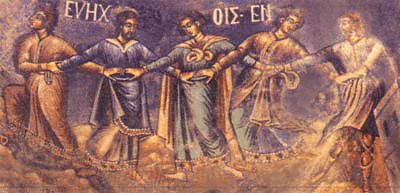

Varys Hasapikos is a traditional Greek folk dance with a recognizable melody. Many aspects of Greek folk music are related to classical Greek and Byzantine church music, and the geographical location of Greece contributed to its folk music being influenced by many other nations. Dance has always played a prominent role in the lives of Greeks, and dance music comprises the largest category of Greek folk music. [16]
Western stringed instruments such as the violin have been used to perform Greek folk music for over 400 years. Small ensembles are often used to accompany dancing and singing, and the instruments in these ensembles often include the clarinet, violin, lute or guitar, santouri (hammered dulcimer), and occasionally a small drum and tambourine. Other frequently used Greek folk instruments include the plucked laouto or bouzouki, [17] [18] and the lyra, a three-stringed bowed fiddle played with the body of the instrument resting on the player’s knee. The lyra is sometimes used in place of the violin, particularly in locations such as the islands of Crete and Karpathos.
In the 1950s, a resurgence of interest in Greek folk music led to a renewed interest in the lyra. Tullia Magrini, a music scholar researching the history of a family of violinists from the Greek island of Crete, noted that the violin appears to have been brought to Crete at some point during the Venetian occupation from 1218-1682. Since instruments in the violin family were not invented until 1495-1505 in Ferrara, Italy, this could not have taken place until the 1500s or later. Although it is likely that other instruments in the violin family such as the cello and viola were also introduced to Greece at this time, these instruments apparently did not gain the popular status that the violin did in playing Greek folk music. It is interesting to note that despite the early arrival of the violin in the repertory and performance of Greek folk music, some Greek folklorist purists claimed the violin was an inappropriate instrument to perform traditional Greek folk music. Magrini asserted:
Since 1955, in Greece, to perform Cretan music with violin was forbidden in all state mass media, because of the nationalistic policy and purism adopted by Greek folklorists. The violin, imported to Crete from Italy during the Venice domination, was interpreted as a foreign instrument, basically unrelated to the Cretan musical tradition, and banned, while the lyra was chosen as the heir and symbol of uncontaminated musical folklore. [19]
Magrini noted that attempting to exclude the violin from Greece was absurd, particularly in light of the violin’s contributions towards Greek folk music:
It must be stressed that the action of remodelling the musical history of Crete begun in the 1950s underrated the very important role that the violin and violin-players had had in working out an important repertoire of Cretan dances and fostered the artificial revival of the lyra that took place after 1955. When Naftis came back to Crete in 1976, the lyra had become the musical symbol of Cretan ethnic identity, even if its organological aspects, performance practice, and repertory gave evidence of the strong influence exerted on it by the violin tradition (According to the [Crete violinist] Papadakis, many lyra players started as violin players). [20]
Although Greek folklorists may regard the violin with distrust, hostility towards the violin is apparently not universally embraced in Greece, because the violin continues to play a prominent role in the performance of Greek folk music throughout Greece today. [21][22]
TECHNIQUE TIPS: The hasapikos dance originated in Constantinople during the Byzantine period, and originally was the dance of the Butcher's Guild of Constantinople (Constantinople, now İstanbul, Turkey, was once part of the Greek empire, and in 1453, became part of the Ottoman Empire). Since this dance was popular throughout Greece, it is known as a Panhellenic dance. Panhellenic means of or relating to all the Greek people, and when a dance is called a Panhellenic dance, it means the particular dance is so well-known throughout Greece that it is not assigned to a specific region.
The hasapikos is generally performed as a male line dance, with a hand to shoulder hold. There are numerous variations of this dance. One variation of the hasapikos dance, the syrtaki, became popular when it was a featured dance in the movie "Zorba the Greek." This movie was released in 1964, and "Zorba's dance" using the dance steps of a syrtaki, was performed to a piece composed by a contemporary Greek composer, Mikis Theodorakis. As a note of explanation, the syrtaki is a combination of two traditional dances: the hasapiko, danced in a slow tempo, and the hasaposerviko, a subgroup of the hasapiko and danced twice as fast. The hasapiko featured in this arrangement is called Varys Hasapikos (varys means heavy or slow, and hasapikos comes from the Greek word hasapis and means butcher). The tempo of this arrangement is andante, meaning a moderately slow, walking speed. As you play this music, imitate the deliberate walking tempo dancers might use to perform this traditional dance. [23] [24] [25] [26]
© Copyright 2025 RK Deverich. All rights reserved.
Although this online violin class is provided free of charge, all rights are reserved and this content is protected by international copyright law. It is illegal to copy, post or publish this content in any form, and displaying any of this material on other websites, blogs or feeds is prohibited. Permission is given for individual users to print pages and perform music from this website for their personal, noncommercial use.